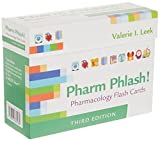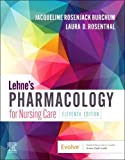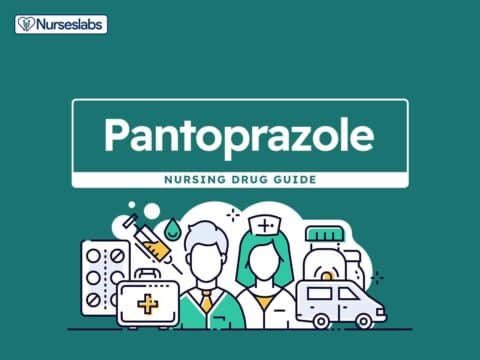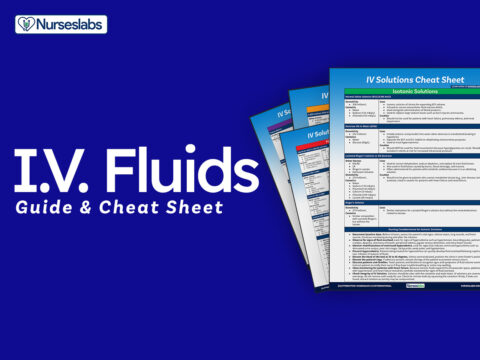Learn about inhaled steroids in this nursing pharmacology guide for student nurses! Get to know its uses, side-effects, nursing considerations and more.
Inhaled steroids have been found to be a very effective treatment for bronchospasm. The drug of choice depends on the individual patient’s response; a patient may have little response to one agent and do very well on another.
Inhaled Steroids: Generic and Brand Names
Here is a list of some of the most commonly encountered inhaled steroids.
- Inhaled steroids:
- beclomethasone (Beclovent)
- budesonide (Pulmicort)
- ciclesonide (Alvesco)
- Fluticasone (Flovent)
- triamcinolone (Azmacort)
What are Inhaled Steroids?
Inhaled steroids are used to decrease the inflammatory response in the airway.
- Inhaling the steroid tends to decrease the numerous systemic effects that are associated with steroid use.
- It is usually useful to try another preparation if one is not effective within 2 to 3 weeks.
Therapeutic actions
The desired actions of inhaled steroids include:
- Decrease the inflammatory response in the airway.
- Increase airflow and facilitate respiration.
- Promotion of beta-adrenergic receptor activity, which may promote smooth muscle relaxation and inhibit bronchoconstriction.
Indication of Inhaled Steroids
Inhaled steroids are indicated for the following:
- Prevention and treatment of asthma.
- Treatment of chronic steroid-dependent bronchial asthma.
- Used as adjunctive therapy for asthma patients who do not respond to traditional bronchodilators.
Pharmacokinetics
These drugs are rapidly absorbed from the respiratory tract, but they from 2 to 3 weeks to reach effective levels.
| Route | Onset | Peak | Duration |
|---|---|---|---|
| Inhalation | Slow | Rapid | 8-12 h |
Contraindications and Cautions
The contraindications and cautions for patients using inhaled steroids include the following:
- Emergency use. Inhaled steroids are not for emergency use and are not for use during an acute asthma attack or status asthmaticus.
- Pregnancy or lactation. They should not be used during pregnancy or lactation unless the benefit to the mother clearly outweighs any potential risk to the fetus or the nursing baby.
- Active respiratory infection. These preparations should be used with caution in any patient who has an active infection of the respiratory system because the depression of the inflammatory response could result in serious illness
Adverse effects
Adverse effects of using inhaled steroids include the following:
- CNS: Irritability, headache.
- Respiratory: Rebound congestion, epistaxis, local infection.
Nursing considerations for Inhaled Steroids
Nursing considerations for a patient using inhaled steroids include the following:
Nursing Assessment
History taking and physical exam of a patient using inhaled steroids include:
- Assess for possible contraindications and cautions: acute asthmatic attacks and allergy to the drugs, which are contraindications; and systemic infections, pregnancy, or lactation, which require cautious use.
- Perform a physical examination to establish baseline data for assessing the effectiveness of the drug and the occurrence of any adverse effects associated with drug therapy.
- Assess temperature to monitor for possible infections.
- Monitor blood pressure, pulse, and auscultation to evaluate cardiovascular response.
- Assess respirations and adventitious sounds to monitor drug effectiveness.
- Examine the nares to evaluate for any lesions that might lead to systemic absorption of the drug.
Nursing Diagnosis and Care Planning
Nursing diagnoses related to drug therapy might include the following:
- Risk for injury related to immunosuppression.
- Acute pain related to local effects of the drug.
- Deficient knowledge regarding drug therapy.
Nursing Implementation with Rationale
Nursing interventions for patients using inhaled steroids include:
- Not for immediate relief. Do not administer inhaled steroids to treat an acute asthma attack or status asthmaticus because these drugs are not intended for the treatment of acute attack and will not provide the immediate relief needed.
- Proper tapering of steroids. Taper systemic steroids carefully during the transfer to inhaled steroids; deaths have occurred from adrenaline insufficiency with sudden withdrawal.
- Use decongestant drops. Have the patient use decongestant drops before using the inhaled steroid to facilitate penetration of the drug if nasal congestion is a problem.
- Oral care. Have the patient rinse the mouth after using the inhaler because this will help to decrease systemic absorption and decrease GI upset and nausea.
- Monitor for signs of infection. Monitor the patient for any sign of respiratory infection; continued use of steroids during acute infection can lead to serious complications related to the depression of the inflammatory and immune responses.
- Educate the client. Provide patient teaching, including the drug name and prescribed dosage, measures to help avoid adverse effects, warning signs that may indicate problems, and the need for periodic monitoring and evaluation, to enhance patient knowledge about drug therapy and to promote compliance.
- Ensure the effectiveness of the drug. Instruct the patient to continue to take the drug to reach and then maintain effective levels (drug takes 2 to 3 weeks to reach effective levels).
- Provide support. Offer support and encouragement to help the patient cope with the disease and the drug regimen.
Evaluation
Evaluation of a patient using inhaled steroids include:
- Monitor patient response to the drug (improved breathing).
- Monitor for adverse effects (nasal irritation, fever, GI upset).
- Evaluate the effectiveness of the teaching plan (patient can name drug, dosage, adverse effects to watch for, specific measures to avoid them, and measures to take to increase the effectiveness of the drug).
- Monitor the effectiveness of other measures to ease breathing.
Recommended Resources
Our recommended nursing pharmacology resources and books:
Disclosure: Included below are affiliate links from Amazon at no additional cost from you. We may earn a small commission from your purchase which will help support us. Thank you! For more information, check out our privacy policy.
Pharm Phlash! Pharmacology Flash Cards #1 BEST SELLER!
Test-yourself review cards put critical clinical information for nearly 400 of the top generic medications at your fingertips. And, you can count on them for accuracy, because each card is based on content from Davis’s Drug Guide for Nurses. Increase your test scores in pharmacology class.

Focus on Pharmacology (8th Edition)
Focus on Nursing Pharmacology makes challenging concepts more approachable. Engaging learning features cultivate your clinical application, critical thinking and patient education capabilities. This updated 8th edition builds on your knowledge of physiology, chemistry and nursing fundamentals to help you conceptualize need-to-know information about each group of drugs.

Pharmacology Made Incredibly Easy (Incredibly Easy! Series®)
Nursing pharmacology guide offers step-by-step guidance so you can grasp the fundamentals in enjoyable Incredibly Easy style. This is the perfect supplement to class materials, offering solid preparation for NCLEX® as well as a handy refresher for experienced nurses. Colorfully illustrated chapters offer clear, concise descriptions of crucial nursing pharmacology concepts and procedures.

Lehne’s Pharmacology for Nursing Care (11th Edition)
The Eleventh Edition of Lehne’s Pharmacology for Nursing Care provides a thorough understanding of key drugs and their implications for nursing care. This text, written by renowned nursing educators, helps you comprehend and apply pharmacology principles. A clear and engaging writing style simplifies complex concepts, making even the most challenging pharmacology content enjoyable. We recommend this book if you want a comprehensive nursing pharmacology guide.

Nursing Drug Handbook
Nursing2023 Drug Handbook delivers evidence-based, nursing-focused drug monographs for nearly 3700 generic, brand-name, and combination drugs. With a tabbed, alphabetical organization and a “New Drugs” section, NDH2023 makes it easy to check drug facts on the spot.

Pharmacology and the Nursing Process
The 10th edition of Pharmacology and the Nursing Process offers practical, user-friendly pharmacology information. The photo atlas contains over 100 unique illustrations and photographs depicting drug administration techniques. Updated drug content reflects the most recent FDA drug approvals, withdrawals, and therapeutic uses.

Mosby’s Pharmacology Memory NoteCards: Visual, Mnemonic, and Memory Aids for Nurses
The 6th edition of Mosby’s Pharmacology Memory NoteCards: Visual, Mnemonic, & Memory Aids for Nurses incorporates illustrations and humor to make studying easier and more enjoyable. This unique pharmacology review can be utilized as a spiral-bound notebook or as individual flashcards, making it ideal for mobile study.

See Also
Here are other nursing pharmacology study guides:
- Nursing Pharmacology – Study Guide for Nurses
Our collection of topics related to nursing pharmacology - Pharmacology Nursing Mnemonics & Tips
These nursing mnemonics aim to simplify the concepts of pharmacology through the use of a simple, concise guide. - Generic Drug Name Stems Cheat Sheet
Learn about these generic drug name stems to help you make sense of drugs easier! - Common Drugs and Their Antidotes
A guide to drug antidotes that nurses should be familiar about. - IV Fluids and Solutions Guide & Cheat Sheet
Get to know the different types of intravenous solutions or IV fluids in this guide and cheat sheet. - Drug Dosage Calculations NCLEX Practice Questions (100+ Items)
Care to take the challenge? This quiz aims to help students and registered nurses alike grasp and master the concepts of medication calculation.
We have a pill for that…
Drug Guides NEW!
Individual drug guides and nursing considerations for the most common medications used in nursing pharmacology:
- Acetaminophen (Tylenol)
- Aspirin
- Atorvastatin (Lipitor)
- Enoxaparin (Lovenox)
- Furosemide (Lasix)
- Gabapentin
- Hydromorphone (Dilaudid)
- Lisinopril
- Metoprolol
- Morphine
Gastrointestinal System Drugs
Respiratory System Drugs
- Antihistamines
- Bronchodilators and Antiasthmatics
- Decongestants
- Expectorants and Mucolytics
- Inhaled Steroids
- Lung Surfactants
Endocrine System Drugs
- Adrenocortical Agents
- Antidiabetic Agents
- Glucose-Elevating Agents
- Hypothalamic Agents
- Insulin
- Parathyroid Agents: Bisphosphonates, Calcitonins
- Pituitary Drugs
- Sulfonylureas
- Thyroid Agents
Autonomic Nervous System Drugs
- Adrenergic Agonists (Sympathomimetics)
- Adrenergic Antagonists (Sympatholytics)
- Anticholinergics (Parasympatholytics)
- Cholinergic Agonists (Parasympathomimetics)
Immune System Drugs
Chemotherapeutic Agents
- Anthelmintics
- Anti-Infective Drugs
- Antibiotics
- Antifungals
- Antineoplastic Agents
- Antiprotozoal Drugs
- Antiviral Drugs
Reproductive System Drugs
Nervous System Drugs
- Antidepressants
- Antiparkinsonism Drugs
- Antiseizure Drugs
- Anxiolytics and Hypnotic Drugs
- General and Local Anesthetics
- Muscle Relaxants
- Narcotics, Narcotic Agonists, and Antimigraine Agents
- Neuromuscular Junction Blocking Agents
- Psychotherapeutic Drugs
Cardiovascular System Drugs
References and Sources
References and sources for this study guide about Inhaled Steroids.
- Hinkle, J. L., & Cheever, K. H. (2018). Brunner and Suddarth’s textbook of medical-surgical nursing. Wolters kluwer india Pvt Ltd.
- Karch, A. M., & Karch. (2011). Focus on nursing pharmacology. Wolters Kluwer Health/Lippincott Williams & Wilkins. [Link]
- Kew, K. M., & Seniukovich, A. (2014). Inhaled steroids and risk of pneumonia for chronic obstructive pulmonary disease. Cochrane Database of Systematic Reviews, (3).
- Katzung, B. G. (2017). Basic and clinical pharmacology. McGraw-Hill Education.
- Lehne, R. A., Moore, L. A., Crosby, L. J., & Hamilton, D. B. (2004). Pharmacology for nursing care.









![Furosemide Nursing Considerations and Patient Teaching [Drug Guide]](https://nurseslabs.com/wp-content/uploads/2023/07/Furosemide-480x360.jpg)


![Lisinopril Nursing Considerations and Patient Teaching [Drug Guide]](https://nurseslabs.com/wp-content/uploads/2023/03/Lisinopril-480x360.jpg)

























Leave a Comment